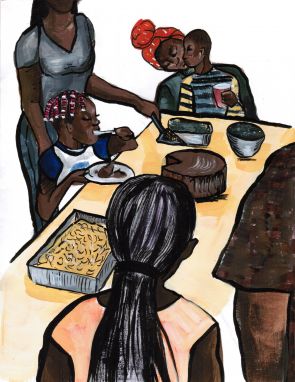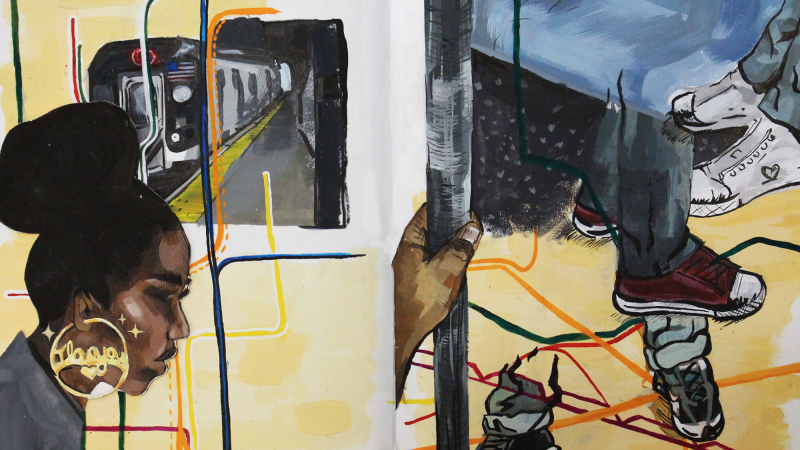Every year, the Scholastic Art & Writing Awards, the nation’s longest-running and most prestigious recognition program for creative teens in grades 7–12, recognizes 16 high school seniors who receive the program’s highest national honor, the Gold Medal Portfolio, which includes a $10,000 scholarship.
Leading up to the Scholastic Art & Writing Awards week-long national celebration in New York City in June, the nonprofit Alliance for Young Artists & Writers will spotlight two Gold Medal Portfolio recipients on their blog each week. This week, they’re celebrating Maya Dixon, an artist from the Bronx in New York, and Triniti Wade, a writer from Miami, Florida.
Scroll down to learn more about Maya and Triniti’s nationally recognized portfolios and to see excerpts of their truly impressive work!
Maya Dixon
In her art portfolio “Essence of Soul,” Maya highlights the essence of the Bronx community through stunning color paintings. “While New York is all I’ve ever known, Manhattan feels foreign yet familiar,” she explains. “It makes me uneasy how much money is poured into only this part of city. Walking through the Upper East Side, there are no liquor stores, no bodegas, not even litter. Even the McDonald’s on 86th and Madison is pristine, almost fake. The contrast of my world and this one never ceases to amaze me. Fast food and sneakers dangling from wires do not line these streets. It’s as if the Bronx has been forgotten about and left to fend for itself. However, this is nothing new for the Bronx. What makes the Bronx the Bronx is its toughness and resilience. It’s a place where marginalized groups have planted roots and learned to thrive.”
“The inherent strength and resilience of those who live here is what I strived to capture in this series. I wanted to illustrate this beauty by capturing seemingly mundane candid moments, from braiding shops to bodegas to bustling barbershops on a Friday evening. The Bronx is more than just the ‘hood.’ It is a community of people and a place that should not be feared, but rather explored for all it has to offer.”

Triniti Wade
Triniti’s nationally recognized writing portfolio, titled “Cherry Seeds” features a mix of poems, scripts, personal essays, short stories, and flash fiction. She describes her work, saying, “The writing in my portfolio explores various aspects of black girlhood. Through these pieces, I hope my audience will be able to acquire a deeper understanding of what it means to be a black girl in America, especially through tales relating to black female sexuality, class, and burgeoning womanhood.”
Coming of Age in the Hood
Personal Essay & Memoir. By Triniti Wade, Grade 12, Age 17.
I’ve never lived in the suburbs, nor have I ever lived in the narrowly defined “hoods” often broadcast on Viceland documentaries. Being so young, it never dawned on me to explore outside of my community, for it seemed as if my neighborhood was the only place that mattered. There was the corner store where I fell in love to the tune of old men with bruised knuckles popping their jaws as they played cards for the millionth time. There was the laundromat where I stood every Sunday morning and watched as my mother loaded mounds of clothes because we couldn’t afford a new washing machine. There were the shabby, abandoned apartment rooms that my childhood friends and I isolated ourselves in as an attempt to recreate the alternate realities we’d seen portrayed on television. In that neighborhood, I formed numerous daydreams and personas to fill my days. My fantasies became sublime depictions of the “ghetto” I soon tried so desperately to escape. The only problem was that I couldn’t actually picture myself anywhere else yet. If not Opa-Locka, then where? If not Liberty City, then where? If I didn’t live confined to the limits of my familiar communities, then where could I escape? Furthermore, why did I want to escape?
The common rhetoric in the Miami ghetto seemed to be an endless chant of “Don’t go where you ain’t s’posed to.” These thinly veiled warnings held little meaning to my ten-year-old self. As I grew older, however, it became easier to analyze the connotation behind these words and what they meant for a black girl in the hood. How would I know where I didn’t belong if I never even bothered to walk beyond my front porch? I spent years pondering the possible answers to questions like these until it seemed as if they were never meant to be answered. Nights spent wrestling between attitude and angst prompted me to ask questions that were often met with unease and annoyance. No one wanted to hear about the awkward ramblings of another poor black kid. Thus my quietude became a shield for me to run behind whenever the weight of my small world seemed to crumble upon my shoulders. My choice to remain silent became a comforter for me to wrap myself up with. It became a prayer. It became a plea. It became a daily reminder of my own ambivalence toward life.
It wasn’t long before my heart began to burst with myriad possibilities. Before the word “escape” even grazed my tongue, I dreamt of a city in which I existed as a whole being, free from the consequences of my past. I still tip-toed around the topic of exploration during afterschool conversations with my parents, no matter how dedicated they were to my well-being. Growing up, I remember hearing that living in the hood was “survival of the fittest.” I remember hearing how the innocence of little girls with strawberry tongues was often stripped away before they could comprehend what the phrase meant. I remember looking up at the sky and thinking about what color I would paint my neighborhood if red didn’t already cover the bodies laid out in parking lots; if red were only a color and not the blood of a child who never learned to ride a bike. If guns were only a myth and not the weapons that killed my brother’s childhood friends. If the hood was only a place and not the reason I heard my mom cry at 3:00 am. If angels could talk would they sit outside my window and ask me about my day, or would they want to hear about the dead bodies that chased me as a kid? If hood politics existed in real life, would my teachers still look at me the same? If I listened hard enough, could I hear what angels sound like?
To see more Gold Medal Portfolio recipients, past and present, visit the Eyes on the Prize series on the Alliance for Young Artists & Writers blog.
© Alliance for Young Artists & Writers/Scholastic Art & Writing Awards. Used with permission.



